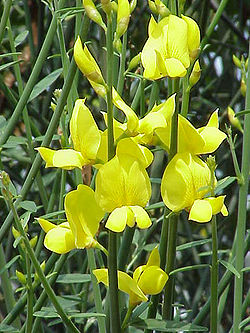Spartium junceum
| Habit | shrub
| |
|---|---|---|
| Height: | ⇕ | 10 ft"ft" can not be assigned to a declared number type with value 10. |
| Width: | ⇔ | 10 ft"ft" can not be assigned to a declared number type with value 10. |
| Lifespan: | ⌛ | perennial |
| Bloom: | ❀ | early spring, mid spring, late spring |
| Exposure: | ☼ | sun |
|---|---|---|
| Features: | ✓ | flowers |
| USDA Zones: | 8 to 10 | |
| Flower features: | ❀ | orange, yellow |
|
Fabaceae > |
Spartium > |
junceum > |
Spanish Broom (Spartium junceum, syn. Genista juncea), also known as Weaver's Broom, is a perennial, leguminous shrub native to the Mediterranean region in southern Europe, southwest Asia and northwest Africa, where it is found in sunny sites, usually on dry, sandy soils. It is the sole species in the genus Spartium, but is closely related to the other brooms in the genera Cytisus and Genista.
Spanish Broom typically grows to 2–4 m tall, rarely 5 m, with main stems up to 5 cm thick, rarely 10 cm. It has thick, somewhat succulent grey-green rush-like shoots with very sparse small deciduous leaves 1–3 cm long and 2–4 mm broad; the leaves are of minimal importance to the plant, with much of the photosynthesis occurring in the green shoots (a water-conserving strategy in its dry climate). In late spring and summer it is covered in profuse fragrant pale yellow flowers 2 cm across. In late summer, its legumes (seed pods) mature black, 4–8 cm long, 6–8 mm broad and 2–3 mm thick; they burst open, often with an audible crack, spreading seed from the parent plant.
It has been widely introduced into other areas, and is regarded as a noxious invasive species in places with a Mediterranean climate such as California and Oregon, central Chile, southeastern Australia, and the Canary Islands.
Read about Spartium junceum in the Standard Cyclopedia of Horticulture
|
|---|
|
Spartium junceum, Linn. (Genista juncea, Lam. Spartianthus junceus, Link). Spanish Broom. Upright shrub, 10 ft. high, with slender, terete, green, rush-like branches sparingly leafy or almost leafless: lvs. oblanceolate to linear, entire, bluish green and sparingly appressed pubescent, 1/2 – 1 1/2 in. long: fls. fragrant, yellow, about 1 in. long, with ample standard: pod linear, pubescent, 2-3 in. long. June-Sept., in Calif. blooming almost the whole year. — There is a double-fld. form. Var. ochroleucum, Sprenger, has whitish fls. CH
|
Read about Spartium junceum in the Standard Cyclopedia of Horticulture
|
|---|
|
Spartium (Greek, spartos, the ancient name of the plant). Syn., Spartianthus. Leguminosae. Ornamental hardy shrub grown chiefly for its bright yellow flowers. Leaves alternate, simple, small: fls. in terminal, loose racemes; calyx split above, hence 1-lipped, with 5 minute teeth; keel incurved, acuminate: pod linear, compressed, many-seeded; seeds with callose appendage at the base, like in Genista.—One species in the Medit. region and the Canary Isls. Allied to Genista and Cytisus, but chiefly distinguished by the 1-lipped calyx. The slender branches yield fiber, which is used in S. France and Spain for making ropes, cords, and cloths. This is a handsome shrub with long and slender rush-like green branches, small and sparse foliage and showy papilionaceous flowers in terminal racemes. It is especially adapted for warmer and drier regions; in the East it is probably hardy as far north as Philadelphia. It becomes naturalized easily, as happened in several localities in South America, whence it was afterward described as S. americanum, Meyen. It grows in almost any kind of well-drained soil and is well suited for planting on exposed sandy and rocky situations. Propagation is by seeds and by greenwood cuttings under glass. For other species sometimes referred to Spartium see Genista and Cytisus. For S. aetnense, Biv., S.ferox, Poir., S. monospermum, Linn., S. radiatum, Linn., and S. virgatum, Ait., see Genista; for S. purgans, Linn., S. scoparium, Linn., and S. multiflorum, Ait., see Cytisus. CH
|
Cultivation
Propagation
Pests and diseases
Varieties
Gallery
References
External links
- w:Spartium junceum. Some of the material on this page may be from Wikipedia, under the Creative Commons license.
- Spartium junceum QR Code (Size 50, 100, 200, 500)
